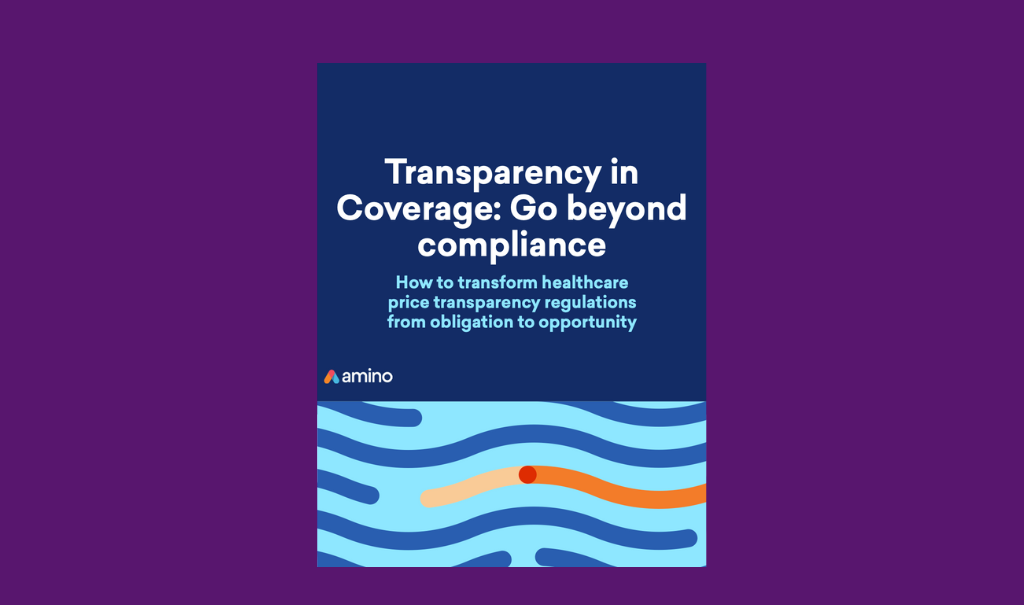
September 09, 2022
Where Transparency in Coverage falls short: Evaluating the quality of healthcare

Lena Kelly
Lena Kelly leads marketing at Amino Health. Frustrated by the opacity of the U.S. healthcare system, she is optimistic about how technology can empower people to make more informed decisions about their health.
The US healthcare system was never set up to benefit consumers—so will TIC change everything? Read this blog to understand the real changes that need to happen in healthcare and why TIC is just one small part of the puzzle.
The American healthcare system was not built to benefit those needing care. The three primary stakeholders in healthcare—medical providers, insurers, and patients—have opposing goals: providers want to maximize their price per service, insurers want to minimize their payments, and patients want trusted and safe care that they can afford.
In a self-insured model, plan sponsors and their members are the biggest losers of this dynamic: without visibility into the cost or quality of the care they seek, patients are unable to make informed purchasing decisions about their care, and their plan sponsors are left to foot the bill.
This convoluted system defies traditional market dynamics. The best way to correct for the healthcare system’s misplaced incentives is to introduce a new level of healthcare consumerism, by which patients are empowered to make choices based on quality, cost, accessibility, and safety depending on their unique priorities and health needs.
The role of new federal healthcare transparency rules
The recently passed Transparency in Coverage (TIC) Rule, which federally mandates greater cost transparency from healthcare providers and insurers, represents the government’s recognition of these misplaced incentives and a shift toward healthcare consumerism.
Though increasing access to cost information is a step in the right direction, providing cost information alone actually proves to be dangerous and expensive, both to the individual seeking care and their plan sponsor.
The danger of cost information without quality
Revealing the cost of care, when unpaired with any contextualizing information on care quality, leaves members with incomplete and inaccurate understandings about the care they could receive.
Plan members often falsely equate higher cost with higher quality, driving them to make high-price healthcare choices, though in reality, the high costs are unrelated to improved health outcomes.
Unless plan sponsors take initiative to contextualize the influx of cost information with reliable quality data, they risk spending huge amounts of wasted money on high-cost, and often unnecessary, care.
There’s no consumer experience that happens without considering both cost and quality. Whether we’re evaluating new technologies, goods, or experiences, humans weigh the cost of said entity against its quality. Why should healthcare be any different?
Here’s the thing: everyone agrees that quality is an important factor in making a healthcare decision. Even the writers of the TIC legislation affirm that “to further innovate around the baseline standards outlined [in the legislation] and include quality information and other metrics not required by the final rules that would assist in consumer decision-making” (page 87 of the legislation).
Equipping members with care quality information not only drives better health outcomes, but it also has a huge effect on an organization's bottom line. When plan sponsors can divert care to relevant point solutions or to providers who recommend appropriate care (like physical therapy before surgery), they stop wasting huge sums of money each year on unnecessary medical spend.
Why care quality is difficult to evaluate
Despite the unanimous agreement on the importance of care quality, accurately evaluating quality is incredibly difficult. Independent groups that develop quality measurement frameworks look at hundreds of different factors to understand whether individual doctors and facilities provide good care, including safety, appropriateness, and experience.
Eric Hargan, former Deputy Secretary of the Department of Health and Human Services (HHS) explains in this webinar that this difficulty is why the writers of TIC strayed from mandating quality transparency in the regulation as it stands today: they simply didn’t know how they could evaluate quality at scale.
Other navigation tools try to incorporate quality into their technologies, but they have failed. Some include qualitative reviews; some try to determine care quality based on a limited data set from hospitals and Medicare. But these sources are either subjective in nature or only reflect the realities of elderly population, not that of the entire American workforce. Data must be comprehensive and accurate to succeed in leading plan members through the chaos of the healthcare system to the right care at the right cost.
Amino Health is unique in its ability to assess quality
Amino Health is one of three organizations, and the only for-profit entity, to achieve a CBE designation, meaning that we are certified by Medicare to develop the quality measures that reflect variations in the healthcare system. Amino is truly creating the federal standard for what qualifies as a high-quality healthcare service.
Of course, a product only delivers value if people use it. Amino’s award-winning user experience is rooted in its history as a direct-to-consumer company; with our obsession with building an intuitive product that educates users along the way, Amino has achieved member engagement rates of over 50% across our book of business. People love the tool and come back again and again when they need care.
TRANSPARENCY IN COVERAGE
Three paths to healthcare price transparency
Download the eBook to learn how you can go beyond compliance

The relationship between healthcare cost and quality isn’t straightforward. In many cases, higher-quality doctors and facilities are actually less expensive than lower-quality ones. Additionally, what we value most from a provider changes depending on our health needs. For a routine service like an MRI, finding a lower-cost option is the highest priority. But for a heart surgery, choosing the most qualified, experienced doctor with the best outcomes matters more than simply picking the lowest price tag.
TIC requires plan sponsors to provide their members with insight into cost information; but healthcare cost and quality can’t be evaluated in isolation. This attempt at introducing healthcare consumerism leaves plan sponsors with a choice. They can choose to make the mandated shoppable tool simple, usable, and valuable…or not.
To make a tangible effect on Americans’ abilities to make informed decisions about their care – which both saves money and improves care outcomes – plan sponsors must deliver a TIC-compliant shoppable tool that contextualizes cost information with robust and complete data on care-quality.
Connect with our Partnership Team
Want to learn how we can help your members transform their healthcare experience in 2025?